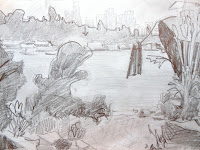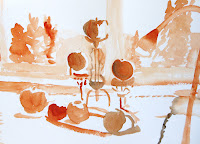Friday, December 23, 2011
Saturday, December 17, 2011
Sketching on Location
Sketching on location -- making quick studies of a subject -- is a great way to develop and practice skills as well as record ideas for more complete painting or drawing. It's also a way to record the light and shadow patterns in a scene before the rapidly moving light source (sun) changes them, or make note of a particular color that a camera may not quite capture. For these reasons, many artists won't leave home without their sketchbooks.
Here are a examples of the different ways I've used such sketches in my art process.
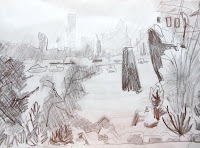 |
| I lowered the horizon in this second sketch to see if I liked it better. I also adjusted some of the values. |
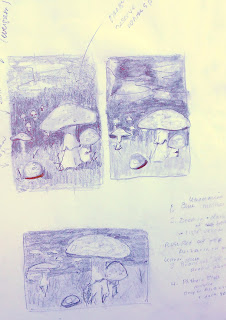 |
| In this example I tried three different compositions. |
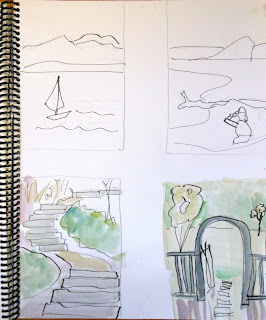 |
| Here I tested ideas for a birthday card I wanted to paint for a friend. I liked the drawings on the bottom the best, so I added color, and then finally decided to use the stair concept for the card. |
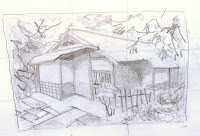 |
| This was a value study for my three Japanese Teahouse watercolors. |
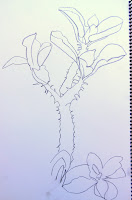 |
| In this sketch, I recorded the interesting edges of the plant. |
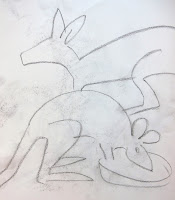 |
| This ultra-quick sketch captures the motion of the kangaroos. |
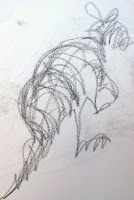 |
| And again. |
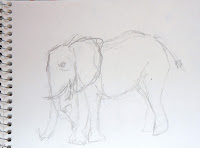 |
| This sketch focuses on the back-and-forth movement of the elephant's trunk and the twitching of his ears and tail. |
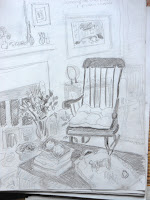 |
| Here I was trying to decide if this view of my living room would make a good composition. |
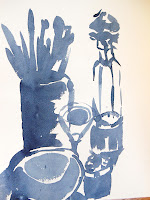 |
| Here's another painted sketch of shadows only. |
Sketching doesn't have to be for a particular purpose, though. Sometimes I like to get together with other artists and sketch for fun. There are many opportunities to sketch in more organized ways. For example, Michele Cooper, who keeps a wonderful sketchbook, participates in the Sketchbook Project.
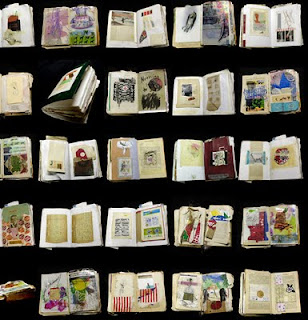 |
| Sketchbooks on display for the Sketchbook Project. |
Several other artist friends take part in Urban Sketchers, which is a group that gets together to sketch in various locations. Also, Catherine Gill hosts a weekly group called Art on Tap, where artists meet at a local pub three Monday evenings a month to sketch. Maybe I'll see you there!
You might also enjoy:
- Artists of the First Nations - A visit to the UBC Museum of Anthropology.
- Robin's Sketchbook - Photos of a watercolor sketchbook.
Sunday, November 20, 2011
Holiday Gifts for Kids in Need
Dear Friends,
I have a personal holiday tradition of buying new clothing for local teens in need. When Bill and I lived in Kirkland, we donated the items to Hopelink, which has offices on the east side of Lake Washington. Last year we moved to Seattle, so we're now supporting an organization here, Treehouse for Kids, that collects gifts (clothing, toys, etc.) for foster kids of all ages. I'll be taking donations to their collection site on Friday morning, December 16. The last day to donate for the holiday drive is Saturday, December 17.
If you want to join me in this endeavor, here's a wish list of items you could buy: Wish List
Or, if you'd rather donate money, you can do so online. Just click the "Donate Now" button on this page: http://www.treehousef...
If you live near Ballard and want me to deliver your donations along with ours, comment on this post or send me a message. If you're not here in Seattle, I hope you'll support a similar organization in your own community and help kids in need during the holidays.
Thanks and Happy Holidays!
Megan
I have a personal holiday tradition of buying new clothing for local teens in need. When Bill and I lived in Kirkland, we donated the items to Hopelink, which has offices on the east side of Lake Washington. Last year we moved to Seattle, so we're now supporting an organization here, Treehouse for Kids, that collects gifts (clothing, toys, etc.) for foster kids of all ages. I'll be taking donations to their collection site on Friday morning, December 16. The last day to donate for the holiday drive is Saturday, December 17.
If you want to join me in this endeavor, here's a wish list of items you could buy: Wish List
Or, if you'd rather donate money, you can do so online. Just click the "Donate Now" button on this page: http://www.treehousef...
If you live near Ballard and want me to deliver your donations along with ours, comment on this post or send me a message. If you're not here in Seattle, I hope you'll support a similar organization in your own community and help kids in need during the holidays.
Megan
Friday, November 11, 2011
Bad BAD BAD Kitty
My neighbors got two adorable kittens this summer which have since turned into cats. I'm becoming very familiar with these animals because their favorite place is our yard, where they stalk the little feathered creatures who come here to eat and drink.
This is a dilemma. I love animals, but I don't love cats eating my little friends. So on seeing one getting ready to do this, I rush into the yard hissing, arms flapping, yelling "go away you stupid cat," and all sorts of other things that probably chip away at my local reputation.
The typical scenario goes something like this.
1. I look out the window and see this flat cat shape in the bottom of the rain garden (the best stalking spot when it isn't raining).
2. I burst out the front door, pretending to be a very VERY dangerous person.
3. The cat calmly gazes up at me.
4. My voice gets louder and louder. My arms flap harder and harder. This finally inspires the cat to move.
5. The cat begins walking towards me purring loudly. I don't think it's getting the idea.
6. The cat begins rubbing against my legs.
7. I pat it.
You might also like:
Meet Bertram
The Yard Robin Liked Me Better
This is a dilemma. I love animals, but I don't love cats eating my little friends. So on seeing one getting ready to do this, I rush into the yard hissing, arms flapping, yelling "go away you stupid cat," and all sorts of other things that probably chip away at my local reputation.
The typical scenario goes something like this.
1. I look out the window and see this flat cat shape in the bottom of the rain garden (the best stalking spot when it isn't raining).
2. I burst out the front door, pretending to be a very VERY dangerous person.
3. The cat calmly gazes up at me.
4. My voice gets louder and louder. My arms flap harder and harder. This finally inspires the cat to move.
5. The cat begins walking towards me purring loudly. I don't think it's getting the idea.
6. The cat begins rubbing against my legs.
7. I pat it.
You might also like:
Meet Bertram
The Yard Robin Liked Me Better
Tuesday, October 4, 2011
Clintavo's Position on Marketing Art via Facebook and Twitter
by Clint Watson
please remember, if the world loses a single work of art you could have produced because you got sucked into playing Farmville, well, that would be, quite frankly, tragic. [...]
Read the rest of this article at:
http://fineartviews.com/blog/35038/clintavos-position-on-marketing-art-via-facebook-and-twitter
----------------------------------------------
This excerpt appears courtesy of FineArtViews Art Marketing Newsletter by FASO,
a free email newsletter about art, marketing, inspiration and fine living for artists,
collectors and galleries (and anyone else who loves art).
For a complimentary subscription, visit: http://www.fineartviews.com
-----------------------------------------------
please remember, if the world loses a single work of art you could have produced because you got sucked into playing Farmville, well, that would be, quite frankly, tragic. [...]
Read the rest of this article at:
http://fineartviews.com/blog/35038/clintavos-position-on-marketing-art-via-facebook-and-twitter
----------------------------------------------
This excerpt appears courtesy of FineArtViews Art Marketing Newsletter by FASO,
a free email newsletter about art, marketing, inspiration and fine living for artists,
collectors and galleries (and anyone else who loves art).
For a complimentary subscription, visit: http://www.fineartviews.com
-----------------------------------------------
Tuesday, September 27, 2011
Art Studio Party and Kathy Collins Talk
Boy, it's been a busy few weeks, and I've gotten out of touch with my blog. Vacations, house guests, parties, talks, and so on... But I have a minute for a quick post so you won't think I've gone away for good.
Sunday was our 49th Street Studio annual party. It was my first, and I had no idea what to expect. What happened was lots of food, art, and about 200 guests. What a blast! I got 10 of my paintings framed up and another five matted to show. It was the first time I've framed anything, and it was a bit of a learning experience. I'm happy with how things turned out, though. Here's a photo of my stuff:
For more about the party, see my post on the 49th Street Studio blog.
Today was Kathy Collins' talk, and it also was a great success. She generously shared her knowledge and experience about the business of art with 14 of us. There was so much information to digest and we all had lots of questions, too much to recap right now (dinner's on the stove).
Kathy is easy to admire, being such a wonderful artist and a fine human being to boot!
Thanks, Kathy!
Sunday was our 49th Street Studio annual party. It was my first, and I had no idea what to expect. What happened was lots of food, art, and about 200 guests. What a blast! I got 10 of my paintings framed up and another five matted to show. It was the first time I've framed anything, and it was a bit of a learning experience. I'm happy with how things turned out, though. Here's a photo of my stuff:
 |
| Some of the paintings I showed at the studio party |
For more about the party, see my post on the 49th Street Studio blog.
Today was Kathy Collins' talk, and it also was a great success. She generously shared her knowledge and experience about the business of art with 14 of us. There was so much information to digest and we all had lots of questions, too much to recap right now (dinner's on the stove).
 |
| Kathy Collins giving a talk on the business of art. |
Thanks, Kathy!
Tuesday, August 30, 2011
Don't forget about "The Business of Art" Talk on Sept 27
This is a reminder to register for Kathy Collins' talk on the business of art. See full details at http://meganseagren.blogspot.com/2011/08/announcing-kathy-collins-talk-on.html.
Topics covered will be:
This event is sponsored by the Seattle Watercolor Meetup Group.
Topics covered will be:
- How Kathy got into the art world from the world of science and medicine
- Improving your art, getting a style
- Organizing your art
- Getting into juried shows
- Getting into a gallery
- Getting your art published in a magazine
- Steps to begin teaching
This event is sponsored by the Seattle Watercolor Meetup Group.
Wednesday, August 17, 2011
Sharp Metal Objects
How I Became a Favorite Great Auntie
I'm great auntie to a passel of little boys belonging to various nieces and nephews. There are seven in all. I love each of them, but one in particular tugs at my heart strings -- a middle child like me. His Dutch name sounds like Out -- at least that's the way it often sounds when his mother says it.
One day Out came to visit with his mother and baby brother. The circular layout of our home is perfect for running, it turns out, and by lunchtime, Out's whirling socks had given our floors a high polish. I was glad when it was time for him to sit at the table to eat. While Out listlessly toyed with his food, I began returning freshly washed knives to their magnetic holder on the wall. I'd raise one up, and when it got close enough, the knife would snap onto the holder.
SNAP went the first knife.
Out perked up.
SNAP went second knife.
Leaping from his chair to my side faster than you could say "Don't jostle me when I'm handling knives," he began peppering me with questions about just how that knife holder worked. Could he try it?
"Umm, no. Maybe in 10 or 15 years."
His eyes remained glued to the knife holder.
This seemed like a good time to go downstairs to the family room, where some art projects were set up. Although the art stuff was a bit dull, the hand cords of my Nordic Track Classic Ski Machine were not. Seems they're good to dangle from.
After a few minutes of dangling, while his mother was occupied with changing baby brother, heading for the stairs, Out declared, "I'll be right back.". After a brief exchange of raised eyebrows with his mother, I followed. In the kitchen, I found Out staring up at the knife holder. Appeased with nothing less than a full description of how it worked, Out learned that metal things such as knives stick to the holder because it's a magnet.
Out began muttering to himself.
"What are you thinking about, Out?" I asked. This might be important information.
"My trucks!" he said. "My red truck is metal. My green truck is metal. My orange car is metal. They'd stick to the mang-ga-net!"
"Why yes!" I agreed, relieved that the subject had turned from knives to trucks. "Metal cars and trucks would stick to the knife holder, if they're made of the right kind of metal."
His curiosity finally satisfied, Out allow me to coax him away from the kitchen and back down to the family room.
Later that afternoon while Out was on his way home with intact fingers and eyeballs, I sat down at the computer and ordered a magnetic knife holder for him. It would be shipped directly to his home, so I emailed his parents to let them know, adding that they might want to mount it on Out's wall to hold some of his trucks and cars.
It's a very fortunate thing that Out's parents have a sense of humor, for when the knife holder arrived, Out opened the package, and -- to his vast and astonished delight -- it contained not only a magnetic knife holder, but real knife as well!
And that's how I became one of Out's very, very favorite great aunties.
Postscript: Since this story was written, two great-nephews and two great nieces have been added to our crowd. AND a girl grandbaby. Now that she's two, she displays a similar attraction to sharp metal objects--in her case cooking knives like her mum uses. Glad I didn't start this one!
You might also enjoy:
I'm great auntie to a passel of little boys belonging to various nieces and nephews. There are seven in all. I love each of them, but one in particular tugs at my heart strings -- a middle child like me. His Dutch name sounds like Out -- at least that's the way it often sounds when his mother says it.
One day Out came to visit with his mother and baby brother. The circular layout of our home is perfect for running, it turns out, and by lunchtime, Out's whirling socks had given our floors a high polish. I was glad when it was time for him to sit at the table to eat. While Out listlessly toyed with his food, I began returning freshly washed knives to their magnetic holder on the wall. I'd raise one up, and when it got close enough, the knife would snap onto the holder.
SNAP went the first knife.
Out perked up.
SNAP went second knife.
Leaping from his chair to my side faster than you could say "Don't jostle me when I'm handling knives," he began peppering me with questions about just how that knife holder worked. Could he try it?
"Umm, no. Maybe in 10 or 15 years."
His eyes remained glued to the knife holder.
This seemed like a good time to go downstairs to the family room, where some art projects were set up. Although the art stuff was a bit dull, the hand cords of my Nordic Track Classic Ski Machine were not. Seems they're good to dangle from.
After a few minutes of dangling, while his mother was occupied with changing baby brother, heading for the stairs, Out declared, "I'll be right back.". After a brief exchange of raised eyebrows with his mother, I followed. In the kitchen, I found Out staring up at the knife holder. Appeased with nothing less than a full description of how it worked, Out learned that metal things such as knives stick to the holder because it's a magnet.
Out began muttering to himself.
"What are you thinking about, Out?" I asked. This might be important information.
"My trucks!" he said. "My red truck is metal. My green truck is metal. My orange car is metal. They'd stick to the mang-ga-net!"
"Why yes!" I agreed, relieved that the subject had turned from knives to trucks. "Metal cars and trucks would stick to the knife holder, if they're made of the right kind of metal."
His curiosity finally satisfied, Out allow me to coax him away from the kitchen and back down to the family room.
Later that afternoon while Out was on his way home with intact fingers and eyeballs, I sat down at the computer and ordered a magnetic knife holder for him. It would be shipped directly to his home, so I emailed his parents to let them know, adding that they might want to mount it on Out's wall to hold some of his trucks and cars.
It's a very fortunate thing that Out's parents have a sense of humor, for when the knife holder arrived, Out opened the package, and -- to his vast and astonished delight -- it contained not only a magnetic knife holder, but real knife as well!
And that's how I became one of Out's very, very favorite great aunties.
You might also enjoy:
- On Being a Role Model - My daughter Liz gets some bad news at school.
- Biker Bob Goes for a Walk - Taking a simple walk isn't all that easy.
Tuesday, August 16, 2011
Leo and the Drive-by
Here's another animation about Leo, the Occasionally Good Dog. There are so many different ways to say his name!
You might also enjoy:
You might also enjoy:
- Leo, The Occasionally Good Dog - Meet my dog Leo.
- Ways to say "Leo": Reading the Menu - Short animated cartoon about the Occasionally Good Dog.
- Another Way to Say Leo - Short animated cartoon about you-know-who.
Tuesday, August 9, 2011
Announcing the 49th Street Studio Blog!
Yeah! I've joined a studio here in Ballard, and volunteered to create a blog for it. Please take a moment to check it out.
You'll notice that the very first post is about our annual art party. I hope you'll be able to join us!
 |
| 49th Street Studio Blog |
You'll notice that the very first post is about our annual art party. I hope you'll be able to join us!
Tuesday, August 2, 2011
Announcing Kathy Collins' Talk on the Business Side of Art
Updates: I corrected Kathy's email address below.
Please note the change from September 20 to September 27.
At some point after you begin taking casual art classes for recreation and before you decide to pawn your children and go to Tahiti to live on the beach and paint, some inevitable questions arise, such as,
Please join us for Kathy's talk on Tuesday, September 27th at 1:30 PM at the Kaewyn Art Gallery in downtown Bothell. The cost is $20 per person. The talk will take about an hour and will be followed by a question and answer session, so write down all those things you've been wondering and Kathy will do her best to help you with an answer or approach that works for you.
IMPORTANT: To guarantee a seat for the talk, please preregister by emailing kathy.collins2 @comcast.net (remove the spaces in the email address).
Topics covered will be:
Please note the change from September 20 to September 27.
At some point after you begin taking casual art classes for recreation and before you decide to pawn your children and go to Tahiti to live on the beach and paint, some inevitable questions arise, such as,
"I have this growing stack of paintings. What should I do with them?"If any of these questions, or similar ones, have occurred to you, then you might want to attend Kathy Collins' talk, The Business of Art. Most people who find themselves drawn to art are not simultaneously drawn to business, but the truth is that the artist needs to know something about business to make the most of their work and their talent. Kathy's been there and has a lot of it figured out. She understands the business end of art from an artist's perspective because she's got her own successful art career.
"How can I buy art supplies without plundering our retirement accounts to pay for them?"
"How can I share my creations with others who will appreciate them?"
Please join us for Kathy's talk on Tuesday, September 27th at 1:30 PM at the Kaewyn Art Gallery in downtown Bothell. The cost is $20 per person. The talk will take about an hour and will be followed by a question and answer session, so write down all those things you've been wondering and Kathy will do her best to help you with an answer or approach that works for you.
IMPORTANT: To guarantee a seat for the talk, please preregister by emailing kathy.collins2 @comcast.net (remove the spaces in the email address).
Topics covered will be:
- How Kathy got into the art world from the world of science and medicine
- Improving your art, getting a style
- Organizing your art
- Getting into juried shows
- Getting into a gallery
- Getting your art published in a magazine
- Steps to begin teaching
| Kathy Collins, "Riverbend," featured in Splash 12. |
Monday, August 1, 2011
More Fear of Paint
Week Two of Kathy Collins' summer session, we did city scenes. I painted this from a B&W photo of Kathy's. The street looks European, so she probably took the picture on her last trip there, earlier this summer.
I started on the left-hand buildings, nearly frozen in fear, repeating, "Oh dear, oh dear, oh dear!" under my breath like a mantra, while applying lots of paint thinned by the teensy bit of water clinging to my brush. By the last stroke on that side of the painting, I was feeling a bit more confident. Turning to the other side, I used some warmer color combinations, painting more freely as I started to get the hang of it.
Just as I once said to my daughter, Liz, after screaming all the way down a particularly difficult Blue ski run, and then realizing at the bottom that I was still alive, I thought "I'd like to try this again sometime."
You might also enjoy:
I started on the left-hand buildings, nearly frozen in fear, repeating, "Oh dear, oh dear, oh dear!" under my breath like a mantra, while applying lots of paint thinned by the teensy bit of water clinging to my brush. By the last stroke on that side of the painting, I was feeling a bit more confident. Turning to the other side, I used some warmer color combinations, painting more freely as I started to get the hang of it.
 |
| Street Somewhere in Europe Probably |
Just as I once said to my daughter, Liz, after screaming all the way down a particularly difficult Blue ski run, and then realizing at the bottom that I was still alive, I thought "I'd like to try this again sometime."
You might also enjoy:
- Overcoming Fear of Paint - Someone once said to expand your abilities and horizons, you should do one thing a day that makes you afraid.
- Painting in the Manner of Thomas Schaller - I create a painting by following Thomas' painting process.
Sunday, July 31, 2011
How Much Stuff Does It Take to Be Happy?
Recently, my young friend Lori wrote about paring down her possessions so she can move to the east coast and attend a writing program. In her post, she lists five benefits of owning less, including
BUT -- what was next? What would really make me and the kids happier? (We were already happy, I should add.) More stuff to follow the earrings?? Accumulating possessions seems to be the goal of many of us in this country. I kept thinking about this. And buying more stuff.
I found it difficult, if not impossible, to go against the flow, to take a different direction than the larger society, regardless of any intentions otherwise. As time went on, though, I began feeling weighed down. Possessions were supposed bring happiness, but the pleasure was short-lived, and then I had to worry about housing, cleaning around, and moving an ever-increasing amount of stuff.
When the kids left home for college about a decade ago, I started paring down, hoping to lighten this burden. About halfway through that process, Bill and I met, married, and merged households, so I got to weed out even more stuff. Then the kids needed us to store "just a few boxes" for them. During that time, I felt like I'd acquired some very bad "garage karma" because no sooner did I get it cleaned out, than it would magically fill up again, with no help from me.
Now, a few years later, I'm in the final stages of what turned into a gigantic effort. Last year, Bill and I moved into the city to be closer to his work and cultural activities. Because homes here cost nearly twice as much per square foot as the suburban home we'd left, and we wanted to tread more lightly on the earth, we bought a small house, small enough, in fact, to be considered a "cottage." However, in spite of my efforts up to now, we still had way too much stuff to fit in it. Now, after another whole year of weeding out, and with some things still to give away, we can finally walk around the house without tripping over too many things.
While it's been a big adjustment to live in such as small space, by today's American standards anyway, I'm pleased to report being much, much happier here than when living in a far larger house with lots and lots more stuff.
In sum, if I had it to do all over again, this would be my theme, as gorgeously performed by Ella Fitzgerald:
You might also enjoy:
- saving money,
- gaining appreciation of the stuff you decide to keep,
- traveling and relocating more easily,
- making other people happy by giving them your castoff things, and
- reducing the urge to buy more stuff and thereby overspend.
To Lori's list, I'd add this bullet:
- feeling great about "treading more lightly on the earth," counteracting the trend seen in this terrific, and terrifying, video:
Anyway, the subject of stuff is one I've been thinking about for years. It started with a study I read in Utne Reader about 15 or so years ago. It reported that the happiest people on earth were living in a tiny town in India, where a person with a stool to sit on was considered rich. In spite of the dearth of physical possessions, the people in this village managed to educate their children from a communal library, maintain good health, and have strong social bonds.
This shocked me. I haven't been able to find it on the web to share it with you, and it may not still be valid, but the point is, it got me thinking. Up until then, like many people around me, I'd measured success in monetary terms. For example, one of my goals was to earn enough money to buy a pair of gold hoop earrings. When I finally had enough extra money for them, I judged I'd really "made it."
BUT -- what was next? What would really make me and the kids happier? (We were already happy, I should add.) More stuff to follow the earrings?? Accumulating possessions seems to be the goal of many of us in this country. I kept thinking about this. And buying more stuff.
I found it difficult, if not impossible, to go against the flow, to take a different direction than the larger society, regardless of any intentions otherwise. As time went on, though, I began feeling weighed down. Possessions were supposed bring happiness, but the pleasure was short-lived, and then I had to worry about housing, cleaning around, and moving an ever-increasing amount of stuff.
When the kids left home for college about a decade ago, I started paring down, hoping to lighten this burden. About halfway through that process, Bill and I met, married, and merged households, so I got to weed out even more stuff. Then the kids needed us to store "just a few boxes" for them. During that time, I felt like I'd acquired some very bad "garage karma" because no sooner did I get it cleaned out, than it would magically fill up again, with no help from me.
Now, a few years later, I'm in the final stages of what turned into a gigantic effort. Last year, Bill and I moved into the city to be closer to his work and cultural activities. Because homes here cost nearly twice as much per square foot as the suburban home we'd left, and we wanted to tread more lightly on the earth, we bought a small house, small enough, in fact, to be considered a "cottage." However, in spite of my efforts up to now, we still had way too much stuff to fit in it. Now, after another whole year of weeding out, and with some things still to give away, we can finally walk around the house without tripping over too many things.
 |
| We fit everything into our cottage, almost. |
In sum, if I had it to do all over again, this would be my theme, as gorgeously performed by Ella Fitzgerald:
You might also enjoy:
- World Environment Day - I never would have heard about this, but for a comment from a reader in Indonesia.
- Buhtan's Gross National Happiness - Would you rather have your government promote happiness or gross domestic product?
Friday, July 29, 2011
Photographing Paintings
UPDATE August 11: I just got my "First Studio" lighting kit from B&H Photo and am getting it set up. I'll write a post about what happens. (I'm never quite sure what will happen when I start tangling with things that attach to the power grid.)
The faint of heart need go no farther. Here's a treatise by Robert Ward from a DPChallenge forum on the how to set up your equipment to photograph paintings. It's too long to tack onto the Digitizing Paintings post (which I've added more info to tonight as well), so I'm giving it a post of it's own.
The faint of heart need go no farther. Here's a treatise by Robert Ward from a DPChallenge forum on the how to set up your equipment to photograph paintings. It's too long to tack onto the Digitizing Paintings post (which I've added more info to tonight as well), so I'm giving it a post of it's own.
Here goes:
----------------------
----------------------
We used to record exhibitions for major museums in California, in San Diego, Los Angeles, and San Francisco. This was back in the 70's. The work was done with large-format cameras on 4x5 film.
If you need to shoot vertical and horizontal paintings both, it's best to do them as two separate groups, because rotating the tripod head to portrait orientation will move the offset of the lens sufficiently to one side to require repositioning the tripod, plumbing it to a different offset from the line.
You now have a geometrically consistent setup and a constant light level across the entire working space. All you have to do is move art on and off the wall, shooting each piece as you go. Use a cable release, and ideally mirror lockup as well. You should also photograph a "color target" (available at camera stores and online) under your controlled setup. You will process the color target image to eliminate any color cast and add slight exposure corrections needed, and then set up an action you can use to batch process all the other images to correct color balance and exposure.
Robt.
Thank you, Robert!
Tuesday, July 19, 2011
Overcoming Fear of Paint
Someone once said that to stretch your limits, it's a good practice to do one thing each day that makes you a bit afraid. That's why I take Kathy Collins' watercolor classes.
In Kathy's classes, we use paint straight from the tube with a dab of water here and there. If you're a watercolor painter, you may understand how doing this could strike fear in a person's heart. My first watercolor teacher gave me the more typical instruction, which involved putting my paint in the little spots for it on the palette and letting it get good and dry before trying to paint. The result, in case you don't already know, is pallid. You must work and work on that hard little gob of paint to get any color from it. This type of teaching may be why you see so many weak-looking paintings. If you look at some of mine, you'll certainly see the effect.
I subsequently took classes from Tom Hoffman, who got me painting much more boldly, but Kathy Collins has turned that up another full notch, at least, with her "straight from the tube" approach.
Kathy's Tuesday morning summer classes started today, and we did flowers. Taking a deep, stabilizing breath to calm my inner quaking, I used a damp 1-1/2 inch flat brush to paint around the top side of the flowers with prussian blue, alizerin crimson, and yellow ocher straight from the tube. Then I added a small amount of water to the paint around the rest of the flowers. A clean, damp brush softened a few edges.
Kathy, of course, is much more adept at this method, and her paintings are really fabulous. But, as they say, practice makes perfect, so I'll be doing a lot more of these in the future.
1/31/12 Update: I just read this interview with Piet Lap (well worth the read, by the way), and I am apparently not alone. Here's an excerpt: Q: Could you accent something most important to master the watercolor?
A: You can't master it, watercolouring. You will always start 'tabula rasa',with a frightening empty sheet of paper.
 |
| Small Roses. 4" X 5" Arches cold pressed paper. |
I subsequently took classes from Tom Hoffman, who got me painting much more boldly, but Kathy Collins has turned that up another full notch, at least, with her "straight from the tube" approach.
Kathy's Tuesday morning summer classes started today, and we did flowers. Taking a deep, stabilizing breath to calm my inner quaking, I used a damp 1-1/2 inch flat brush to paint around the top side of the flowers with prussian blue, alizerin crimson, and yellow ocher straight from the tube. Then I added a small amount of water to the paint around the rest of the flowers. A clean, damp brush softened a few edges.
 e e |
| Roses in Blue. 11" X 15" Arches cold pressed paper. |
 |
| Rose in a Glass. 4" X 5" Arches cold pressed paper. There were a few minutes left to paint, so I did this small one and the one at the beginning of this post. |
1/31/12 Update: I just read this interview with Piet Lap (well worth the read, by the way), and I am apparently not alone. Here's an excerpt: Q: Could you accent something most important to master the watercolor?
A: You can't master it, watercolouring. You will always start 'tabula rasa',with a frightening empty sheet of paper.
Friday, July 8, 2011
A Painter of Crows
I seem to have happened upon a kindred spirit, Kathleen A. Johnson, Two Crows Studio. She's done a number of crow paintings. I'm absolutely inspired!
 |
| Seven Crows at Night by Kathleen A Johnson |
Wednesday, July 6, 2011
Bhutan's Gross National Happiness
I just learned about this on Create and Share, and then found this video and more background in a Wikipedia article. Here's the deal: the US along with many other countries, measure the success of their policies by using "Gross Domestic Product" as an indicator. Since 1972 the goal of Bhutan's government has been to support and improve the people's happiness, using "Gross National Happiness" as an indicator. If you could choose, which one would you prefer that your government use?
BTW, I just read this article, which reports that Bhutan has attained the position of #8 in the world in terms of its people's happiness, whereas the US ranks #23.
BTW, I just read this article, which reports that Bhutan has attained the position of #8 in the world in terms of its people's happiness, whereas the US ranks #23.
Monday, July 4, 2011
Painting in the Manner of Thomas Schaller
Thomas Schaller is a wonderful watercolor artist I follow on Facebook. I've always admired the way he can paint his main subject emerging from a misty background, and have wondered how he achieves that effect. A couple of weeks ago Thomas posted a series of photos to depict his painting process, so I decided to create my own painting by using his method, to see whether I could get a similar misty result.
Here's the Facebook album with Thomas Schaller's painting process.
From reading about his process, I learned that Thomas puts down a second wash right over his first wash before it's dry. My watercolor teachers have always said that, although you can put thicker paint over a wash that's still wet or damp, you should never put down a second wash until the first is completely dry. I've always obediently let my first layer dry before putting on another wash, but ignoring this rule is, as I discovered from this experiment, Thomas' secret for getting that misty background. Here's one caveat, though, based on my prior experience: be sure to entirely cover the first wash with the second one if you wish to avoid "blooms" at the edges of the second wash. I also learned that you have to paint really fast to actually get the second wash on before the first becomes too dry to produce the desired misty effect.
Here's my first attempt to paint in the manner of Thomas Schaller. Notice all that lovely mist in the background! (Be sure to read Thomas' comment below this picture.)
I put a link to this post on Thomas Schaller's Facebook page, and he's already responded with this clarification about his process:
Here's the Facebook album with Thomas Schaller's painting process.
From reading about his process, I learned that Thomas puts down a second wash right over his first wash before it's dry. My watercolor teachers have always said that, although you can put thicker paint over a wash that's still wet or damp, you should never put down a second wash until the first is completely dry. I've always obediently let my first layer dry before putting on another wash, but ignoring this rule is, as I discovered from this experiment, Thomas' secret for getting that misty background. Here's one caveat, though, based on my prior experience: be sure to entirely cover the first wash with the second one if you wish to avoid "blooms" at the edges of the second wash. I also learned that you have to paint really fast to actually get the second wash on before the first becomes too dry to produce the desired misty effect.
Here's my first attempt to paint in the manner of Thomas Schaller. Notice all that lovely mist in the background! (Be sure to read Thomas' comment below this picture.)
 |
| Dewey Lakes from Naches Loop Trail |
I put a link to this post on Thomas Schaller's Facebook page, and he's already responded with this clarification about his process:
thomas w. schaller - watercolor artist wrote: "Thanks so much Megan. Just looked at your blog post - very nice! I appreciate it greatly. The only clarification is that in this painting, my first wash was still wet, but only at the lower portion - because of the steep angle, the top part was fairly dry so that i could keep the edges of the buildings pretty clean - then they melted into the wetter lower portion. I know you'd figure it out, but as you can imagine - nothing but a real disaster if you go into a completely wet wash too soon -))"Thank you, Thomas!!! It was a lucky thing, then, that I was too slow to put my second wash into a completely wet first wash.
Friday, July 1, 2011
Leo, the Occasionally Good Dog, Can't Seem to Stay Out of Trouble
 |
| Leo is rudely interrupted while reading the menu. |
- Leo, The Occasionally Good Dog - Leo isn't always bad. Plus, he really, really wants to be good.
- One Time When Leo Was Good - Liz and Jenn disagree. They don't think Leo really wants to be good at all. So in this story, I document how good he actually is.
- Biker Bob Goes for a Walk - A simple walk isn't all that easy.
- Seals are Smarter Than Leo - A pair of seals has a laugh at Leo's expense.
- Ways to say "Leo," Part 1: Reading the Menu - Animated cartoon.
- Another Way to Say Leo - Another animated cartoon.
Crow Science
 |
| Crows teach each other who's who. |
http://www.pbs.org/wnet/nature/a-murder-of-crows-full-episode/5977/
A Murder of Crows
If you're still doubting about the human-like qualities of crows, watch this video about a crow who fed and cared for an abandoned kitten:
Friday, June 24, 2011
Help Name the Baby Crows
Update: There is now just one baby crow remaining out of the three, and he has been named Ned. I learned from watching the PBS video, A Murder of Crows, that the attrition rate of baby crows is very high, probably typical of most birds. In their study, only one out of the original eight youngsters made it to the end of the study, which was only a few months long. Anyway, we're enjoying watching and listening to Ned.
Original Story:
As you know, Bertram and Corvina have three youngsters now. To write stories about them, I need to know what their names are. Lucy, a young friend and fellow crow watcher, has kindly provided six ideas. Please help narrow these choices down by picking your three favorites in the poll on the upper-right part of this page.
Original Story:
As you know, Bertram and Corvina have three youngsters now. To write stories about them, I need to know what their names are. Lucy, a young friend and fellow crow watcher, has kindly provided six ideas. Please help narrow these choices down by picking your three favorites in the poll on the upper-right part of this page.
Thursday, June 23, 2011
New Kids on the Block
Last week I spent a day digging out the rockery in front of our house, all the while serenaded by the loud squawks of one or more of Bertram and Corvina's babies. Yes, the long-awaited time had finally arrived, heralded by lots and lots of noise.
Once baby crows get big enough, they leave the nest and start walking around on the tree branches, flapping their wings to strengthen them. Looking down from a height and not yet being able to fly must make them feel very insecure, and they let the world hear about it in a manner impossible to ignore. If you're not sure what a young crow sounds like, just imagine an exceptionally loud and obnoxious "crying" babydoll.
WHAAya. WHAAya. WHAAya. WHAAya. WHAAya. WHAAya. (Repeat indefinitely)
Once baby crows get big enough, they leave the nest and start walking around on the tree branches, flapping their wings to strengthen them. Looking down from a height and not yet being able to fly must make them feel very insecure, and they let the world hear about it in a manner impossible to ignore. If you're not sure what a young crow sounds like, just imagine an exceptionally loud and obnoxious "crying" babydoll.
WHAAya. WHAAya. WHAAya. WHAAya. WHAAya. WHAAya. (Repeat indefinitely)
 |
| One of Bertram and Corvina's kids. |
Wednesday, June 15, 2011
Listen to Orca Whales Live!
Here in the Pacific Northwest, we love our Orca whales so much that scientists have installed microphones to listen to their sounds, just like moms and dads listen to baby monitors. The microphones are called hydrophones because they work under water. There's a whole network of these hydrophones in the Salish Sea and Puget Sound, and anyone can listen to them online. In fact, you're encouraged to listen and help monitor the whales' calls to help scientists identify which pod is making them.
Scientists, along with the rest of us living in this region, are worried because the Orcas, also known as Killer Whales, are stressed, and some of them here are dying prematurely for no apparent reason, so their population is dwindling. One theory is that ship and boat motor noises, among other things, are stressing them out, so scientists are listening to help figure out what's going on.
You can see the locations of the hydrophones and listen to them on the Orcasound Hydrophone Network site. It has a map with markers showing the locations of the hydrophones. You can click on a marker to hear any sounds being made at that location. (You may need to install some software first. The page has information about what you need.) You can also listen to recordings to learn about the unique sounds the different whale pods make, and explore lots of other interesting stuff. A different site has links to web cams recording live video of different locations. Check it out!
Also be sure to visit the Killer Whale Tales web site, which has lots of information about the endangered Orcas in our area. For children, download this free booklet from Killer Whale Tales that explains all about Orcas and has fun activities: Orca Booklet for Children. (They say the booklet's for children, but I'm sure enjoying it!) For more information about the research being done on the effects of man-made noise on the Orcas, see this article.
 |
| Orcas Live! on the Hydrophone Network |
You can see the locations of the hydrophones and listen to them on the Orcasound Hydrophone Network site. It has a map with markers showing the locations of the hydrophones. You can click on a marker to hear any sounds being made at that location. (You may need to install some software first. The page has information about what you need.) You can also listen to recordings to learn about the unique sounds the different whale pods make, and explore lots of other interesting stuff. A different site has links to web cams recording live video of different locations. Check it out!
Also be sure to visit the Killer Whale Tales web site, which has lots of information about the endangered Orcas in our area. For children, download this free booklet from Killer Whale Tales that explains all about Orcas and has fun activities: Orca Booklet for Children. (They say the booklet's for children, but I'm sure enjoying it!) For more information about the research being done on the effects of man-made noise on the Orcas, see this article.
If you're interested in ways that you can help Orcas, see Rain Gardening for Orcas.
And read this story about the birthday party for a 100-year-old Orca.
Share this post:
Listen to Orca whales live on the Hydrophone Network. | |
Subscribe to:
Posts (Atom)


